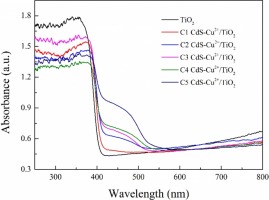Molecular Catalysis ( IF 3.9 ) Pub Date : 2018-02-20 , DOI: 10.1016/j.mcat.2018.01.005 Min Cheng , Sen Yang , Rong Chen , Xun Zhu , Qiang Liao , Yi Huang

|
In this letter, an effective photocatalytic reduction of CO2 by using CdS-Cu2+/TiO2 nanorod array films photocatalyst under visible light was studied. TiO2 nanorod array films were prepared by the hydrothermal method, after which Cu2+ ions and CdS quantum dots (QDs) were deposited on the TiO2 nanorod arrays using the ultrasonic-assisted sequential cation adsorption method and successive ionic layer adsorption and reaction (SILAR) method respectively. The composition, morphology and optical property of the samples were characterized by X-ray diffraction (XRD), scanning electron microscope (SEM), transmission electron microscope (TEM), X-ray photoelectric spectroscopy (XPS) and UV–vis diffuse reflectance spectra (DRS). The loading amount of CdS QDs was regulated by controlling the deposition cycles which demonstrates correspondingly optical behaviors. Their photocatalytic activities were evaluated by reduction of gas-phase CO2 to estimate the ethanol yield under various operating parameters, including the CdS QDs concentration, CO2 flow rate and reaction temperature. The experiment results showed that when the SILAR method cycle deposition was two, the reaction product yield reached the maximum, and the ethanol yield was 109.12 μmol/g-cat h at a flow rate of 4 mL/min and under the reaction system temperature of 80 °C. The highly efficient photocatalytic activities of CdS-Cu2+/TiO2 nanorod array films in the reduction process of CO2 were attributed to the combination of one-dimensional (1D) nanostructure with decorating Cu2+ ions and CdS QDs, which restrain recombination of the electron hole pairs and broaden the visible-light response. In addition, the photocatalytic mechanism was discussed to understand the experimental results over the CdS-Cu2+/TiO2 nanorod array films.
中文翻译:

可见光响应CdS敏化的TiO 2纳米棒阵列膜,可有效地光催化还原气相CO 2
本文研究了在可见光下使用CdS-Cu 2+ / TiO 2纳米棒阵列膜光催化剂对CO 2的有效光催化还原。水热法制备TiO 2纳米棒阵列膜,然后在TiO 2上沉积Cu 2+离子和CdS量子点(QDs)纳米棒阵列分别使用超声辅助顺序阳离子吸附法和连续离子层吸附和反应(SILAR)方法。通过X射线衍射(XRD),扫描电子显微镜(SEM),透射电子显微镜(TEM),X射线光电光谱(XPS)和UV-vis漫反射光谱对样品的组成,形态和光学性质进行了表征。 (DRS)。通过控制沉积周期来调节CdS QD的负载量,这表明了相应的光学行为。通过还原气相CO 2评估了它们的光催化活性,以估算各种操作参数(包括CdS QDs浓度,CO 2)下的乙醇收率。流速和反应温度。实验结果表明,在4mL / min的流速和4℃的反应体系温度下,当SILAR方法的循环沉积次数为2时,反应产物的收率达到最大值,乙醇的收率为109.12μmol/ g-cat h。 80℃。CdS-Cu 2+ / TiO 2纳米棒阵列膜在CO 2还原过程中的高效光催化活性归因于一维(1D)纳米结构与装饰性Cu 2+离子和CdS QD的结合,从而抑制了重组电子空穴对的分布并扩大了可见光响应。此外,讨论了光催化机理以了解CdS-Cu 2+上的实验结果。/ TiO 2纳米棒阵列膜。











































 京公网安备 11010802027423号
京公网安备 11010802027423号